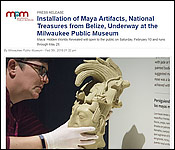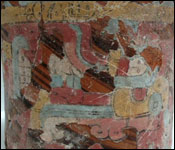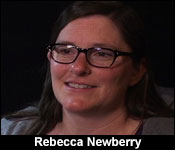

 Belize's most prized Maya artifacts were on the move once again last week. They make up part of the traveling show called Maya: Hidden Worlds Revealed - which we've visited in Minnesota, Boston and Dallas. The show has also been to San Diego, Denver, San Antonio, and now, it has arrived at the Milwaukee Public Museum.
Belize's most prized Maya artifacts were on the move once again last week. They make up part of the traveling show called Maya: Hidden Worlds Revealed - which we've visited in Minnesota, Boston and Dallas. The show has also been to San Diego, Denver, San Antonio, and now, it has arrived at the Milwaukee Public Museum.
It was set up last week after a 1,500 mile journey where, once again, all the prized pieces of antiquity arrived intact. The show in Milwaukee opened up in the bitter cold on Saturday, February 10 and runs through May 28.
After the Milwaukee show closes in May, the exhibit travels to Salt Lake City, Utah. The show - comprising the largest array of Belizean artifacts ever assembled - has been on tour for five and a half years.
We visited it in Boston almost three years ago to see the care, the precision and studious attention to detail which go into handling and transporting these antiquities. Here's a repeat of that story:..
Jules Vasquez Reporting
The mouth of the historic Charles River is dammed at the Boston Museum of Science inside, oblivious to the river's pull, technicians are working with precision to disassemble the display cases known as vitrines which contain some of Belize; most previous artefacts.
They will use this device known as a genie lift where suction cups grip and lift the enormously heavy plexi-glass cover.
Debbie Linn - Travelling Exhibits Conservator
 "And the machines gets cranked so this whole vitrines gets lifted up while being guided these two gentlemen on the side and i't quite an amazing process. These vitrines are incredibly heavy but it needs to be done so carefully because the artefacts in the case can't be jiggled and can't be vibrating during this process. Nothing can be bumped into them, it needs to be very smooth very careful lifting up of this very heavy piece of plexi glass."
"And the machines gets cranked so this whole vitrines gets lifted up while being guided these two gentlemen on the side and i't quite an amazing process. These vitrines are incredibly heavy but it needs to be done so carefully because the artefacts in the case can't be jiggled and can't be vibrating during this process. Nothing can be bumped into them, it needs to be very smooth very careful lifting up of this very heavy piece of plexi glass."
And after the cover is lifted and removed with tender care, The NICH crew moves in to move each artefact with even more tender care.
Two escorts walk in front to make sure nothing is in the way. Yusleidy Chan is learning the responsibilities of what is known as the courier from Sherilyne Jones. The courier is the boss, she has the final say over all dealings with the objects:
Sherilyne Jones - Director, Museum of Belize & Houses of Culture
 "Well, we are here that that punctilious level of care is taken. These objects represent our history, they represent our culture, and so it is our responsibility as custodians to ensure their viability, to ensure that at every point throughout this loan that they are taken care of with the utmost care."
"Well, we are here that that punctilious level of care is taken. These objects represent our history, they represent our culture, and so it is our responsibility as custodians to ensure their viability, to ensure that at every point throughout this loan that they are taken care of with the utmost care."
Sherilyne Jones - Director, Museum of Belize & Houses of Culture
"What we're doing is we're processing the artefacts as we remove them from the display cases. Its called conditioning, it's just taking a visual of the object 360 degrees, making comparisons with the notes that we did when we took them out of the crates and put them in. There's always some level of anxiety - you never know how the elements the time it's been on display how that would affect the object."
And to minimise the anxiety and eliminate uncertainty, there are rules, and manuals and notes:
Peter Garland - Manager of Temporary Exhibits
 "There's a same principle that you follow with everything. Anytime you have artefacts, there's a whole set of rules that come into play, and everyone learns those rules and no objects gets priority over another."
"There's a same principle that you follow with everything. Anytime you have artefacts, there's a whole set of rules that come into play, and everyone learns those rules and no objects gets priority over another."
Sherilyne Jones - Director, Museum of Belize & Houses of Culture
"So there are instructions on how to lift an object, where to touch the object, how to wrap the object so that it's all secure and safe at all times. There's instructions on how to hold it, there's instructions on how to place it inside the crates, or in the bins, and then there are sponges or protective padding that you place in, and all those have a precise way of how it goes in so that the object itself doesn't move when it's in transit."
In fact, as strange as it may sound, these artefacts are safer here on the road than they are in storage back in Belize - that's because the place they are stored in Belize is called, "the Dungeon":
Sherilyne Jones - Director, Museum of Belize & Houses of Culture
"The risks that they are exposed to here in any of these museums in the United States, far, is so minimal compared to what we actually have what right now. The present condition our storage facility in Belize is, is an abomination to be honest they are safer here in a controlled environment."
 Rebecca Newberry - Conservator
Rebecca Newberry - Conservator
"But I worry about it going back into the dungeon if it goes back to the dungeon unprotected because it is for fragile and so sensitive more of the design will be originally excavated. Cause the dungeon I mean the ceiling drips in some of those rooms it's a terrible place to store artefacts. I understand there's not many more places. The only thing it has going for it, it's locked and secure and hard to break into but that's about it. Should be high priority to find another place to store all that stuff because it does make me nervous to send all this beautiful material we are taking so much careful care of back to a place they could be dripped on and flooded - all that kind of stuff."
Sherilyne Jones - Director, Museum of Belize & Houses of Culture
"So for me to take an object that's on this display or on a loan right now, and take it back to the dungeon, it will be like taking it back in time, it will be totally reversing all the steps we have done to get it to where it is now. We would just totally undo all that."
So far the pieces have travelled thousands of miles crisscrossing the USA without damage.



